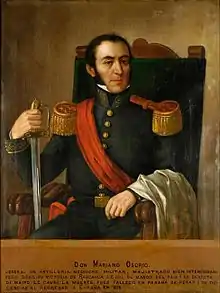Mariano Osorio
Mariano de Osorio (Latin American Spanish: [maˈɾjano ðe oˈsoɾjo]; 1777–1819) was a Spanish general and Governor of Chile, from 1814 to 1815.
Mariano Osorio | |
|---|---|
 | |
| Royal Governor of Chile | |
| In office January 4, 1818 – April 5, 1818 | |
| Monarch | Ferdinand VII |
| Preceded by | José Ordóñez |
| Succeeded by | Position Abolished |
| In office October 10, 1814 – December 26, 1815 | |
| Monarch | Ferdinand VII |
| Preceded by | Gabino Gaínza y Fernández de Medrano (As Captain General) |
| Succeeded by | Francisco Marcó del Pont |
| Personal details | |
| Born | 1777 Seville, Spain |
| Died | 1819 Havana, Cuba |
| Spouse | Joaquina de la Pezuela |
| Profession | Brigadier General |
| Military service | |
| Allegiance | |
| Battles/wars | Peninsular War |
Early career
Osorio was born in Seville, Spain. He joined the Spanish army and as many of his contemporaries, his military career began during the Spanish Peninsular War in 1808 as an artillery general, as well as the professor for mathematics in the military school. In 1810, was appointed head of the military factory of Catalonia. In 1812, was destined to the Royal Army in Peru.
In 1812 he resettled in Peru, where he married Joaquina de la Pezuela, daughter of Peruvian Viceroy Joaquín de la Pezuela. In the Disaster of Rancagua (1814) he was able to defeat the forces of Bernardo O'Higgins and Jose Miguel Carrera. In the same year he became the Governor of Chile.
Chile
With Osorio's victory at Rancagua, the period known as "reconquest" (Reconquista) of Chile had begun. Osorio sought to reinstate order and justice and with military measures he prevented the onslaught of the insurgents.
In 1816 he returned to Lima and Francisco Marcó del Pont was made new Governor of Chile. When the Spaniards lost the Battle of Chacabuco, he returned to Chile. There he succeeded in securing victory in the Second Battle of Cancha Rayada on March 18, 1818. At this battle O'Higgins's arm was injured.
The Battle of Maipu, however, was a major defeat for the Spaniards, and it signified the end of the Spanish authority in almost all of Chile, with the exception of the island of Chiloé and the city of Valdivia.
_Pillars_of_Hercules_Variant.svg.png.webp)